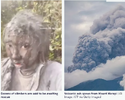You are using an out of date browser. It may not display this or other websites correctly.
You should upgrade or use an alternative browser.
You should upgrade or use an alternative browser.
Volcanoes Erupting All Over
- Thread starter Laura
- Start date
XPan
The Living Force
Krakatoa, Indonesia
26 Nov 2023
The famous volcano just had an eruption. German Vulkane.net wrote an article about the event.


Well-known island volcano in Indonesia erupts
earthquake activity was previously elevated
In the Indonesian Sunda Strait, the strait between the islands of Sumatra and Java, the island volcano Anak Krakatau has erupted. The first eruption occurred at 12:46 WIB when an ash cloud rose 600 metres above crater height. Three further eruptions followed. In the last event so far, the volcanic ash rose 1000 metres above crater height. According to the VAAC Darwin, the volcanic ash reached a height of 1800 metres above sea level and drifted in a north-westerly direction. Images show that red-hot tephra was also ejected.
The final explosion produced a seismic signal lasting 45 seconds and had a maximum amplitude of 78 mm. Seismicity was slightly elevated for weeks before the eruption. In the first week of November, it reached a peak with almost 140 volcanic-induced earthquakes in one day. The eruptions therefore did not come as a complete surprise.
Large quantities of water no longer appear to be involved in the explosions, as the crater is now above sea level again after the collapse in 2018 and is closed.
Iwo Jima (Ioto), Indonesia
26 Nov 2023
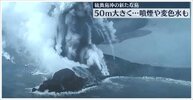
However, another island volcano is currently causing a stir:
This is located in Japanese territorial waters off the coast of the island of Iwo Jima (Ioto) and only celebrated its birthday at the end of October. Since then, an island measuring 450 x 200 metres has been building up and it is not yet possible to say with any certainty that it will establish itself in the long term. But if the eruptions continue and the island continues to grow, it is within the realms of possibility.
In general, the birth of a new volcanic island is a long-term process that does not take place without strong labour pains. It often takes several cycles of creation and destruction, birth and decline, for new land to emerge. The question is how long "in the long run" means. Even on Anak Kraktau, there is no guarantee that the island can remain above the waterline for long periods of time. When the flank collapsed in 2018, the island lost two thirds of its total height. Even the part with the summit crater disappeared to just below the water surface. But now the young island volcano is doing its best to grow again.
END OF ARTICLE
26 Nov 2023
The famous volcano just had an eruption. German Vulkane.net wrote an article about the event.

Anak Krakatau ist am 26.11.23 ausgebrochen - Vulkane Net Newsblog
Im indonesischen Sunda-Strait, der Meerenge zwischen den Inseln Sumatra und Java, ist der Inselvulkan Anak Krakatau ausgebrochen.
www.vulkane.net

Well-known island volcano in Indonesia erupts
earthquake activity was previously elevated
In the Indonesian Sunda Strait, the strait between the islands of Sumatra and Java, the island volcano Anak Krakatau has erupted. The first eruption occurred at 12:46 WIB when an ash cloud rose 600 metres above crater height. Three further eruptions followed. In the last event so far, the volcanic ash rose 1000 metres above crater height. According to the VAAC Darwin, the volcanic ash reached a height of 1800 metres above sea level and drifted in a north-westerly direction. Images show that red-hot tephra was also ejected.
The final explosion produced a seismic signal lasting 45 seconds and had a maximum amplitude of 78 mm. Seismicity was slightly elevated for weeks before the eruption. In the first week of November, it reached a peak with almost 140 volcanic-induced earthquakes in one day. The eruptions therefore did not come as a complete surprise.
Large quantities of water no longer appear to be involved in the explosions, as the crater is now above sea level again after the collapse in 2018 and is closed.
Iwo Jima (Ioto), Indonesia
26 Nov 2023

However, another island volcano is currently causing a stir:
This is located in Japanese territorial waters off the coast of the island of Iwo Jima (Ioto) and only celebrated its birthday at the end of October. Since then, an island measuring 450 x 200 metres has been building up and it is not yet possible to say with any certainty that it will establish itself in the long term. But if the eruptions continue and the island continues to grow, it is within the realms of possibility.
In general, the birth of a new volcanic island is a long-term process that does not take place without strong labour pains. It often takes several cycles of creation and destruction, birth and decline, for new land to emerge. The question is how long "in the long run" means. Even on Anak Kraktau, there is no guarantee that the island can remain above the waterline for long periods of time. When the flank collapsed in 2018, the island lost two thirds of its total height. Even the part with the summit crater disappeared to just below the water surface. But now the young island volcano is doing its best to grow again.
END OF ARTICLE
XPan
The Living Force
Grindavík, Iceland
26 Nov 2023
Another article from the same source, German Vulkane.net also wrote about the situation in Iceland, which appears to have calmed down, as the lava appears to have cooled by 300°C within the nearby fault/sill.

Risk of eruption declining
Ground uplift on Iceland has slowed significantly - risk of eruption decreasing

Today, there were a good 250 earthquakes
along the magmatic passage near Grindavik. Most of them had low magnitudes and manifested themselves at a depth of 3-6 kilometres. The graphs of the GPS measurements show that the ground uplift has now decreased significantly almost everywhere. One exception is the VMOS measuring station, which is located north-west of Grindavik. There, the ground is still rising at a rate of 3 mm per day. While vertical displacement is generally declining, many stations are still recording significant horizontal displacement.
In an interview on MBL, Magnús Tumi Guðmundsson,
Professor of Geophysics at the University of Iceland, said that a good 90 % of the melt in the dyke has now solidified. As the magmatic dyke is only 2 metres wide on average, this happens quite quickly, as the surrounding crustal rock is significantly cooler than the melt, and the melt is practically quenched due to the dyke's large contact area and low thickness. It must be remembered, however, that although the melt has cooled down to the solidus temperature, it is still a long way from cooling down.
The solidus temperature of basalt magma
is slightly less than 1000 degrees Celsius. It can be assumed that the melt penetrated the dyke at temperatures of slightly more than 1250 degrees Celsius and has since cooled by around 300 degrees. However, there is still melt in the centre of the dyke that could erupt, but the probability of this is steadily decreasing, although there is still a risk of eruption.
In general, it currently looks as if everything depends on the influx of new melt into the sill under Svartsengi. As this has been decreasing since yesterday, it is quite possible that the outbreak will not materialise for the time being. Until yesterday, it still looked as if the sill would be filled with magma again by the end of the month to the same extent as before the intrusion of the melt into the magmatic vein, which would have meant that the risk of eruption or the risk of new vein formation would have been very high again. In fact, these observations only represent a snapshot and the situation can change from one second to the next.
END OF ARTICLE
26 Nov 2023
Another article from the same source, German Vulkane.net also wrote about the situation in Iceland, which appears to have calmed down, as the lava appears to have cooled by 300°C within the nearby fault/sill.

Island: Gefahr einer Eruption rückläufig - Vulkane Net Newsblog
Heute gab es entlang des magmatischen Gangs bei Grindavik gut 250 Erdbeben. Die meisten hatten geringe Magnituden.
www.vulkane.net
Risk of eruption declining
Ground uplift on Iceland has slowed significantly - risk of eruption decreasing

Today, there were a good 250 earthquakes
along the magmatic passage near Grindavik. Most of them had low magnitudes and manifested themselves at a depth of 3-6 kilometres. The graphs of the GPS measurements show that the ground uplift has now decreased significantly almost everywhere. One exception is the VMOS measuring station, which is located north-west of Grindavik. There, the ground is still rising at a rate of 3 mm per day. While vertical displacement is generally declining, many stations are still recording significant horizontal displacement.
In an interview on MBL, Magnús Tumi Guðmundsson,
Professor of Geophysics at the University of Iceland, said that a good 90 % of the melt in the dyke has now solidified. As the magmatic dyke is only 2 metres wide on average, this happens quite quickly, as the surrounding crustal rock is significantly cooler than the melt, and the melt is practically quenched due to the dyke's large contact area and low thickness. It must be remembered, however, that although the melt has cooled down to the solidus temperature, it is still a long way from cooling down.
The solidus temperature of basalt magma
is slightly less than 1000 degrees Celsius. It can be assumed that the melt penetrated the dyke at temperatures of slightly more than 1250 degrees Celsius and has since cooled by around 300 degrees. However, there is still melt in the centre of the dyke that could erupt, but the probability of this is steadily decreasing, although there is still a risk of eruption.
In general, it currently looks as if everything depends on the influx of new melt into the sill under Svartsengi. As this has been decreasing since yesterday, it is quite possible that the outbreak will not materialise for the time being. Until yesterday, it still looked as if the sill would be filled with magma again by the end of the month to the same extent as before the intrusion of the melt into the magmatic vein, which would have meant that the risk of eruption or the risk of new vein formation would have been very high again. In fact, these observations only represent a snapshot and the situation can change from one second to the next.
END OF ARTICLE
XPan
The Living Force
Etna, Sicily - Italy
24 Nov 2023
At our famous volcano, located on the east side of Sicily in southern Italy, Etna volcano had a longer period of strombolian activity - which might be a precursor for a new paroxysm in the near future. German Vulkane.net wrote an article about it, and I extracted some of the wonderful images people (Etna Walk) at the volcano facebook channel took from the activity.

Etna with frequent Strombolian eruptions
- paroxysm could start soon
Etna is currently not only cloud-free in its summit area, but is also producing a steady stream of Strombolian eruptions, which can be easily observed on the livecams. On one of the cameras from the new south-east crater, it looks as if glowing lava is already flowing through the gap in the southern flank. It is difficult to judge from the still images whether it is red-hot tephra rolling across the ground or whether a lava flow is actually on its way. However, the tremor is still producing its jagged pattern without definitely taking off. Therefore, the paroxysm could still take some time, if there is one.
Update 25.11.23:
The paroxysm did not occur overnight. Instead, there were short-lived phases of increased Strombolian activity in line with the fluctuating tremor, which even made it onto the German news channels this morning. The scenery is breathtaking, as a lot of snow fell over the course of the week and the almost full moon illuminated the scene. Accordingly, great photos were shared on social media.
The eruptions produced a large amount of glowing tephra
which was deposited in the crater area, but also on the flanks of the New South East Crater or rolled down the flanks. This caused a moderate heat radiation with 85 MW power. A good 10 years ago, I once experienced such a long heating phase on Etna before a paroxysm. It lasted a good 5 days, and when the main eruption finally began, I was on my way to the airport again. I wonder how long the current little game will continue? Of course, there doesn't necessarily have to be a paroxysmal eruption, but the probability is high. But as we have seen in the last 2 weeks with the example of Iceland: Volcanoes don't give a damn about expectations and probabilities.
END OF ARTICLE

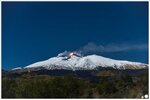
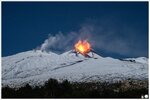

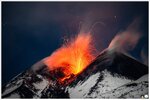

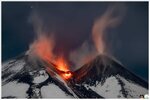

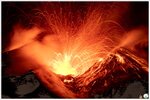
Followed by another article written 2 days later
Etna, Sicily - Italy
26 Nov 2023

Strombolian activity on Mount Etna is persistent

The intense strombolian activity on Mount Etna continues for the fourth day in a row.
Several vents of the New South-East Crater are involved in the activity. What is special about this eruption phase is the cyclical rise and fall in activity. An eyewitness describes that there is a peak phase lasting several minutes practically every hour, during which there are a particularly large number of eruptions. Some of them are very strong and are produced by bursting lava bubbles that spread glowing tephra in an almost spherical shape and scatter it particularly far.
Strong winds displaced the explosion noises in a south-easterly direction, so that they were increasingly heard in some villages at the foot of the volcano, which naturally caused some concern among local residents. But in principle, people know their volcano and react calmly to its activities as long as no lava flow threatens their homes.
It was the same wind that made it difficult for the INGV scientists to detect infrasound signals and determine the frequency of the explosions. Despite this, a short report was issued pointing out that even small amounts of volcanic ash are being produced, which is why there could be light ash fallout in some localities downwind. The clearly fluctuating tremor was also described.
Similar activity has already occurred more frequently on Mount Etna. For example, it was observed between paroxysms in spring 2021. I am also familiar with it from 2014, when there was a series of capped paroxysms. Reliable forecasts cannot be derived from the volcano's behaviour, but it is possible to draw up some scenarios as to how it could continue:
• Activity continues at this level and then ends.
• There is a longer-lasting phase of strombolian eruptions, which can become even stronger or during which short lava flows are produced.
• The activity increases to a paroxysm.
• According to the INGV, there is currently no significant ground uplift above the normal level. It therefore currently seems rather unlikely that the activity is the prelude to an imminent flank eruption.
END OF ARTICLE
24 Nov 2023
At our famous volcano, located on the east side of Sicily in southern Italy, Etna volcano had a longer period of strombolian activity - which might be a precursor for a new paroxysm in the near future. German Vulkane.net wrote an article about it, and I extracted some of the wonderful images people (Etna Walk) at the volcano facebook channel took from the activity.

Ätna schießt sich ein - News vom 24.11.23 - Vulkane Net Newsblog
Der Ätna ist aktuell in seinem Gipfelbereich nicht nur wolkenfrei, sondern erzeugt auch am laufenden band strombolianische Eruptionen.
www.vulkane.net
Etna with frequent Strombolian eruptions
- paroxysm could start soon
Etna is currently not only cloud-free in its summit area, but is also producing a steady stream of Strombolian eruptions, which can be easily observed on the livecams. On one of the cameras from the new south-east crater, it looks as if glowing lava is already flowing through the gap in the southern flank. It is difficult to judge from the still images whether it is red-hot tephra rolling across the ground or whether a lava flow is actually on its way. However, the tremor is still producing its jagged pattern without definitely taking off. Therefore, the paroxysm could still take some time, if there is one.
Update 25.11.23:
The paroxysm did not occur overnight. Instead, there were short-lived phases of increased Strombolian activity in line with the fluctuating tremor, which even made it onto the German news channels this morning. The scenery is breathtaking, as a lot of snow fell over the course of the week and the almost full moon illuminated the scene. Accordingly, great photos were shared on social media.
The eruptions produced a large amount of glowing tephra
which was deposited in the crater area, but also on the flanks of the New South East Crater or rolled down the flanks. This caused a moderate heat radiation with 85 MW power. A good 10 years ago, I once experienced such a long heating phase on Etna before a paroxysm. It lasted a good 5 days, and when the main eruption finally began, I was on my way to the airport again. I wonder how long the current little game will continue? Of course, there doesn't necessarily have to be a paroxysmal eruption, but the probability is high. But as we have seen in the last 2 weeks with the example of Iceland: Volcanoes don't give a damn about expectations and probabilities.
END OF ARTICLE









Followed by another article written 2 days later
Etna, Sicily - Italy
26 Nov 2023

Ätna mit anhaltender Aktivität am 26.11.23 - Vulkane Net Newsblog
Den vierten Tag in Folge geht die intensive strombolianische Tätigkeit am Ätna weiter. Der NSEC feuert aus mehreren Rohren glühende Tephra.
www.vulkane.net
Strombolian activity on Mount Etna is persistent

The intense strombolian activity on Mount Etna continues for the fourth day in a row.
Several vents of the New South-East Crater are involved in the activity. What is special about this eruption phase is the cyclical rise and fall in activity. An eyewitness describes that there is a peak phase lasting several minutes practically every hour, during which there are a particularly large number of eruptions. Some of them are very strong and are produced by bursting lava bubbles that spread glowing tephra in an almost spherical shape and scatter it particularly far.
Strong winds displaced the explosion noises in a south-easterly direction, so that they were increasingly heard in some villages at the foot of the volcano, which naturally caused some concern among local residents. But in principle, people know their volcano and react calmly to its activities as long as no lava flow threatens their homes.
It was the same wind that made it difficult for the INGV scientists to detect infrasound signals and determine the frequency of the explosions. Despite this, a short report was issued pointing out that even small amounts of volcanic ash are being produced, which is why there could be light ash fallout in some localities downwind. The clearly fluctuating tremor was also described.
Similar activity has already occurred more frequently on Mount Etna. For example, it was observed between paroxysms in spring 2021. I am also familiar with it from 2014, when there was a series of capped paroxysms. Reliable forecasts cannot be derived from the volcano's behaviour, but it is possible to draw up some scenarios as to how it could continue:
• Activity continues at this level and then ends.
• There is a longer-lasting phase of strombolian eruptions, which can become even stronger or during which short lava flows are produced.
• The activity increases to a paroxysm.
• According to the INGV, there is currently no significant ground uplift above the normal level. It therefore currently seems rather unlikely that the activity is the prelude to an imminent flank eruption.
END OF ARTICLE
Last edited:
The #Coast Guard conducted a volcanic observation of #Iwojima by #Sea Guardian on Thursday, November 23.
As a result of the observations, eruptive activity was observed on Niijima Island off the southern coast of Iwo Jima.
Click here for a view of the eruption of Niijima off Oohama, Iwo Jima (infrared) ↓ Click here for a view of the eruption of Niijima off Oohama, Iwo Jima (infrared)
Liliea
Jedi Council Member
ANAK KRAKATAU ERUPTS
Mount Anak Krakatau, situated in the waters of the Sunda Strait, erupted on the afternoon of Nov 27, sending a plume of ash some 2,160 m (7,090 ft) above sea level.That was the volcano’s second eruption of the day, with the first, as noted by the PVMBG, spewing ash some 1,660 m (5,450 ft) ASL.
People have been urged to stay well-clear of the volcano — in a 5 km (3.1 mile) radius.
The nearest settlement is on Sebesi Island, 16.5 km (10.25 miles) away.
Udi, a residents of one of the island’s villages, said that the eruption sparked panic:
“We, the people of Sebesi Island Village, could not sleep since last night because the rumbling sound was loud like the sound of thunder.”
Mount Anak Krakatau erupted nine times from Sunday morning through Monday afternoon.
Eruptions have been documented into Tuesday (Nov 28), too:
Krakatau hari ini tgl 28-11-2023 .terus mengeluarkan matrial"nya,suara dentuman nya kayak boom.
Location:anak gunung Krakatau
Dok. Lampung selatan pic.twitter.com/v3FZVidS5B
— FPMKI (@InfoFPMKI) November 28, 2023
Anak Krakatau’s eruptive history is peppered with VEI 1s and 2s.
A powerful VEI 3 popped off in 2018 which resulted in a large underwater collapse and a deadly tsunami.
XPan
The Living Force
Grindavík, Iceland
29 Nov 2023
It appears that we get mixed signals revolving SW Iceland. I have been following Icelandic news outlets - and while there has been speculations, opinions and experts making their statements, nobody seemed to know anything exactly. While in the mean time things calmed down quite a bit (relatively). However, forces are still at work - and in a way it looks like that the relative calm makes things even more uncertain, especially for the people from Grindavík vs authorities.
German Vulkane.net (by Marc Szeglat) wrote following today:

Seismicity fluctuates and was higher tonight than before
- bad news for grindavinkings
As reported by IMO, there were a good 180 weak earthquakes along the magmatic corridor in the first 6 hours of the day. That was almost twice as many as the night before. Yesterday there were only around 300 tremors throughout the day. The strongest earthquake had a magnitude of 2.3 and was located near Hagafell.
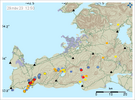
According to a report on the Iceland-Geology website
the summit area of the Keilir volcano, which lies to the east of Fagradalsfjall, is said to have shifted. This resulted in heavy landslides and rockfalls. Boulders the size of caravans are said to have fallen. It remains unclear whether this only happened yesterday or whether it is a recent discovery that took place during the dyke formation. In any case, this illustrates once again how large the earth movements were or are.
For the Grindavikings there was not quite such good news last night
because in a television discussion programme on RUV, Víðir Reynisson, Director of the Civil Defence Department, said that the inhabitants of the village will only be allowed to return to Grindavik permanently when the land uplift has completely stopped and the geological event is over. Before that, an eruption or new dyke intrusion must be permanently expected.
Víðir went on to say that the land in Svartsengi is still rising
faster now than before the passage formed on 10 November. This means that the danger of an eruption has not yet been averted. In general, the most likely location for an eruption is thought to be in the area of the Sundhnúkar crater series.
However, the latest GPS values show that ground uplift has once again decreased at most measuring stations. The values are now practically everywhere below 1 cm per day and are likely to have assumed approximately the same uplift rates as before the formation of the passage. In my opinion, there is still a high risk of eruption, but the risk of a particularly large eruption decreases with each passing day.
END OF ARTICLE / translated with DeepL
29 Nov 2023
It appears that we get mixed signals revolving SW Iceland. I have been following Icelandic news outlets - and while there has been speculations, opinions and experts making their statements, nobody seemed to know anything exactly. While in the mean time things calmed down quite a bit (relatively). However, forces are still at work - and in a way it looks like that the relative calm makes things even more uncertain, especially for the people from Grindavík vs authorities.
German Vulkane.net (by Marc Szeglat) wrote following today:

Island: Seismizität etwas höher - News vom 29.11.23 - Vulkane Net Newsblog
Wie IMO berichtet, gab es in den ersten 6 Tagestunden gut 180 schwache Erdbeben entlang des magmatischen Gangs.
www.vulkane.net
Seismicity fluctuates and was higher tonight than before
- bad news for grindavinkings
As reported by IMO, there were a good 180 weak earthquakes along the magmatic corridor in the first 6 hours of the day. That was almost twice as many as the night before. Yesterday there were only around 300 tremors throughout the day. The strongest earthquake had a magnitude of 2.3 and was located near Hagafell.

According to a report on the Iceland-Geology website
the summit area of the Keilir volcano, which lies to the east of Fagradalsfjall, is said to have shifted. This resulted in heavy landslides and rockfalls. Boulders the size of caravans are said to have fallen. It remains unclear whether this only happened yesterday or whether it is a recent discovery that took place during the dyke formation. In any case, this illustrates once again how large the earth movements were or are.
For the Grindavikings there was not quite such good news last night
because in a television discussion programme on RUV, Víðir Reynisson, Director of the Civil Defence Department, said that the inhabitants of the village will only be allowed to return to Grindavik permanently when the land uplift has completely stopped and the geological event is over. Before that, an eruption or new dyke intrusion must be permanently expected.
Víðir went on to say that the land in Svartsengi is still rising
faster now than before the passage formed on 10 November. This means that the danger of an eruption has not yet been averted. In general, the most likely location for an eruption is thought to be in the area of the Sundhnúkar crater series.
However, the latest GPS values show that ground uplift has once again decreased at most measuring stations. The values are now practically everywhere below 1 cm per day and are likely to have assumed approximately the same uplift rates as before the formation of the passage. In my opinion, there is still a high risk of eruption, but the risk of a particularly large eruption decreases with each passing day.
END OF ARTICLE / translated with DeepL
Strombolian activity fueled by the Southeast Crater of #Etna has been intensifying significantly for several hours. The emitted ash is being pushed by winds in a north/northeast direction. Photo taken from Vincenzo Modica's webcam
Add
Java
Mount Marapi eruption, Sunday 3 December 2023 at around 15.00 WIB. Video from WAG Disaster Alert, taken from Balai Gurah, Agam
L-2
After the eruption, now the areas around Mount Marapi are being hit by sand rain. Not ash, but actually fine sand
L-3
Ash rained in Canduang, Sunday (3/12) at 16.18 WIB. Video recorded by Instagram friends (at) Pdg24jam

 www.mirror.co.uk
www.mirror.co.uk
Mauna Loa Volcano Eruption Anniversary Marked By USGS
Dec 3, 2023 Big Island Video News
This is an edited version of the video produced by the USGS. The full video can be found on the USGS Hawaiian Volcano observatory website here (https://www.usgs.gov/media/videos/mau...) and here (https://www.usgs.gov/media/videos/mau...)
Mount Marapi eruption, Sunday 3 December 2023 at around 15.00 WIB. Video from WAG Disaster Alert, taken from Balai Gurah, Agam
L-2
After the eruption, now the areas around Mount Marapi are being hit by sand rain. Not ash, but actually fine sand
L-3
Ash rained in Canduang, Sunday (3/12) at 16.18 WIB. Video recorded by Instagram friends (at) Pdg24jam

Horrifying volcano clip shows trapped climbers covered in ash begging for rescue
WARNING, DISTRESSING FOOTAGE: Mount Marapi in the West Sumatra province of Indonesia erupted on Sunday spewing white-and-grey ash plumes about 9,800ft (3,000m) into the air and leaving dozens of climbers trapped and waiting for rescue
A horrific video shows climbers covered in ash as 42 people await rescue after Mount Marapi erupted.
The volcano in the West Sumatra province of Indonesia erupted on Sunday, spewing white-and-grey ash plumes about 9,800ft (3,000m) into the air, with hot ash clouds blowing several miles to the north, according to Indonesia's Volcanology and Geological Hazard Mitigation Centre.
According to reports, of 70 climbers, 28 have so far been successfully evacuated, with the rest still trapped. There were no casualties, however, said Ahmad Rifandi, an official at the Marapi monitoring post, adding that villagers have been advised to stay 1.8 miles (3km) from the crater's mouth and be aware of the danger of potential lava. National Disaster Management Agency spokesman Abdul Muhari said several villages were blanketed with falling ash.
He said Marapi's eruption alert was maintained at the second-highest level and that authorities have been closely monitoring the volcano after sensors picked up increasing activity in recent weeks. Japan's Meteorological Agency said on Sunday that it is currently assessing the possibility of a tsunami in the country because of Marapi's activity.
If a tsunami reaches Japanese coasts, the earliest possible swelling is expected in the Okinawa region at around 2100 JST (0900 GMT), it said. The nearly 9,480ft (2,900M) mountain has been active since January when it erupted, generating dense ash-and-steam plumes that rose as high as 1,300ft (400m) above the crater. No casualties were reported.
Mr Rifandi said: "For the ash rain, it has reached to Bukittinggi city," he said, referring to the third-largest city in West Sumatra that has a population of more than 100,000. It is hoped for people who have activities around Marapi mountain to wear hats, glasses and masks."
"The column of ash was observed in grey colour with thick intensity leaning toward the east," according to Hendra Gunawan, head of Indonesia's Centre of Volcanology and Geological Hazard Mitigation, in a statement. "The eruption is still ongoing." Marapi is among more than 120 active volcanoes in Indonesia, which is prone to seismic upheaval due to its location on the Pacific Ring of Fire, an arc of volcanoes and fault lines encircling the Pacific Basin.
Marapi Volcano Volcanic Ash Advisory: HIGH-LEVEL ERUPTION TO FL500 MOV WSW OBS VA DTG: 03/0840Z to 50000 ft (15200 m)
Marapi volcano (Sumatra, Indonesia) eruption news & activity updates / VolcanoDiscovery
www.volcanodiscovery.com
Mauna Loa Volcano Eruption Anniversary Marked By USGS
This is an edited version of the video produced by the USGS. The full video can be found on the USGS Hawaiian Volcano observatory website here (https://www.usgs.gov/media/videos/mau...) and here (https://www.usgs.gov/media/videos/mau...)
New eruption phase of Erta Alé volcano in Ethiopia
Extensive lava flows have been observed from the North and South craters in the past few days.
What was that light? It took more than two minutes to travel that section. What do you think?
Translated from Spanish by
WARNING: New eruptive pulse of the Japanese #volcán #Sakurajima today December 10 at 10:29 a.m. 2023High emission column, spectacular capture #Kagoshima #Japón Via @iyarkai_earth
impressive lenticular cloud at volcano #Popocatépetl , Mexico.A few hours ago these beautiful images of a lenticular cloud were captured over the snow-capped volcano.
Hmm

Translated from Spanish by
WARNING: New eruptive pulse of the Japanese #volcán #Sakurajima today December 10 at 10:29 a.m. 2023High emission column, spectacular capture #Kagoshima #Japón Via @iyarkai_earth
impressive lenticular cloud at volcano #Popocatépetl , Mexico.A few hours ago these beautiful images of a lenticular cloud were captured over the snow-capped volcano.
Hmm

Session Date: February 25th 2023
[...]
(MK Scarlett) There is a theory that connects the formation of cloud anomaly with future earthquakes, and a study published in 2022 says, "The physical mechanism of cloud anomaly was likely caused by electric field, which linked active fault, atmosphere circuit conduction current, and cloud anomaly, and thus provides a reasonable hypothesis of cloud anomaly." Does this connection exist?
A: Yes
Q: (MK Scarlett) Can so-called "orographic" clouds, such as lenticular ones, in some cases, be precursors of earthquakes?
A: Yes
Q: (MK Scarlett) What is the average period (in days) between the atmospheric fluctuation that forms these cloud anomalies and a potential earthquake?
A: 3 to 7.
Q: (Joe) Some of those clouds were seen in Turkey - strange clouds. They were kinda like domes with a hole in the middle, almost like a hat.
(Andromeda) How long before?
(Joe) A few days, I think.



USGS.gov | Science for a changing world
We provide science about the natural hazards that threaten lives and livelihoods; the water, energy, minerals, and other natural resources we rely on; the health of our ecosystems and environment; and the impacts of climate and land-use change. Our scientists develop new methods and tools to...
Low-level eruptive activity continued at Shishaldin Volcano over the past week. Frequent, small, low-frequency earthquakes and minor explosions were detected throughout the week. Minor steam emissions were observed in web camera views this morning and weakly elevated surface temperatures were observed in satellite imagery of the summit occasionally this week. No sulfur dioxide emissions were detected in satellite data.
Thirteen significant explosive events have occurred at Shishaldin since July 12, 2023. These events have been preceded by increases in seismicity in the hours to days before they occur. It is unknown how long this period of ongoing activity will last. However, previous eruptions of Shishaldin Volcano have lasted weeks to months with repeated cycles of eruptive activity like those seen since July.
Local seismic and infrasound sensors, web cameras, and a geodetic network monitor Shishaldin Volcano. In addition to the local monitoring network,
AVO uses nearby geophysical networks, regional infrasound and lightning data, and satellite observations to detect eruptions.

The Earth's Newest Volcano Is Spewing Lava Rivers
Mother Earth is putting on a fiery show! The planet's newest volcano has decided to steal the spotlight, erupting in grand fashion and spewing rivers of molten lava. Picture this natural spectacle: a volcanic performance complete with glowing lava rivers flowing down the slopes. Situated in a remote part of the South Sandwich Islands, this newly minted volcano is a testament to the dynamic and ever-changing nature of our planet. Scientists are geeking out over the chance to study this fresh eruption, providing us with a front-row seat to Earth's spectacular geologic theater.
Iceland Volcano Erupts After Weeks of Quake Activity
The Reykjanes volcano in southwest Iceland erupted on Monday, spewing lava and smoke into the air, after weeks of intense earthquake activity, the country's Meteorological Office said.
Fearing a significant outbreak on the Reykjanes peninsula, authorities last month evacuated the nearly 4,000 inhabitants of the fishing town of Grindavik and closed the nearby Blue Lagoon geothermal spa.
"Warning: Eruption has started north of Grindavik by Hagafell," the Met Office said on its website.
Images and a livestream broadcast by Reuters showed molten rock spewing like fountains from fissures in the ground, their bright-yellow and orange colours set in sharp contrast against the dark night sky.
Icelandic police said they had raised their alert level as a result of the outbreak and the country's civil defence warned the public not to approach the area while emergency personnel assessed the situation.
A coast guard helicopter was going to be in the air shortly to confirm the exact location and size of the eruption, the Met Office said.
Reykjavik's international airport, which is located nearby, remained open.
"At the moment, there are no disruptions to arrivals or departures at Keflavík Airport," it said on its website.
The Reykjanes peninsula in recent years saw several eruptions in unpopulated areas, but the latest outbreak could pose a risk to the Grindavik town, authorities have said.
The area had seen thousands of earthquakes in the last two months but the magnitudes had declined in recent week, leading some experts to think risk of an eruption had abated.
XPan
The Living Force
Preliminary eruption map
18 Dec 2023 • 22.17 local Icelandic time (?)
In order to see where exactly the active vent is located. Supposedly the lava is flowing both to the north and east.

Here the beginning, the very first moment
Source:
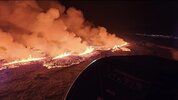
Webcams

 www.livefromiceland.is
www.livefromiceland.is

 www.livefromiceland.is
www.livefromiceland.is

 www.livefromiceland.is
www.livefromiceland.is

 www.livefromiceland.is
www.livefromiceland.is
Multiview

 www.livefromiceland.is
www.livefromiceland.is
18 Dec 2023 • 22.17 local Icelandic time (?)
In order to see where exactly the active vent is located. Supposedly the lava is flowing both to the north and east.

Here the beginning, the very first moment
Source:
December 19 at 00:30
According to the latest measurements, the seismic activity is moving south towards Grindavík. The measured activity is just east of the magma tunnel that formed on November 10. This development of the seismic activity, together with measurements from GPS devices, is an indication that the magma is moving to the southwest and the eruption could extend in the direction of Grindavík.
18 Dec 2023 • 23:19
The first location of the fountain and the approximate length of the crack based on the very first information can be seen below. The eruption began at 22.17 following the earthquake that started around 21.
More information is expected from a flight with the Coast Guard's helicopter.
The estimated length of the crack is about 3.5 and has grown quite rapidly.
For comparison, the length of the fissure in the eruption at Litla-Hrút was about 8-900 m.
The estimated lava flow in the eruption is around 100 to 200 cubic meters per second, which is many times more than in previous eruptions on the Reykjanes Peninsula in recent years.

Webcams

Sundhnúkar - Live from Iceland - Webcams around Iceland
Looking towards the eruption near Sundhnúkagígar, north of Grindavík, from Mt. Þorbjörn. The eruption started December 18th at 22:17:17. Watch live feeds from our webcams with spectacular views of Iceland. Our streaming cameras are placed all around Iceland and broadcast 24/7. The ultimate slow TV!

Langihryggur - Live from Iceland - Webcams around Iceland
Monitoring Fagradalsfjall from Langihryggur. Watch live feeds from our webcams with spectacular views of Iceland. Our streaming cameras are placed all around Iceland and broadcast 24/7. The ultimate slow TV!

Litli-Hrútur - Live from Iceland - Webcams around Iceland
Looking from Grænavatnseggjar towards Litli-Hrútur. Watch live feeds from our webcams with spectacular views of Iceland. Our streaming cameras are placed all around Iceland and broadcast 24/7. The ultimate slow TV!

Perlan over Reykjavík - West - Live from Iceland - Webcams around Iceland
View towards Skerjafjörður and Reykjavík Airport from the top of Perlan. Watch live feeds from our webcams with spectacular views of Iceland. Our streaming cameras are placed all around Iceland and broadcast 24/7. The ultimate slow TV!
Multiview

Multiview - Live from Iceland - Webcams around Iceland
Watch live feeds from our webcams with spectacular views of Iceland. Our streaming cameras are placed all around Iceland and broadcast 24/7. The ultimate slow TV!
Last edited:

